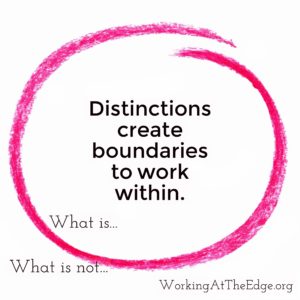 Education is filled with its fair share of jargon: personalized learning, digital transformation, digital leadership, etc. As practitioners in the field, we will often seek out definitions when we need to quickly make sense of complex terminology. You’ve probably heard about a term like personalized learning, “We need a definition of that.” One of my takeaways from the recent Pioneer Lab Training is that a shift in paradigm from school-centered to learner-centered requires a shift in the way we approach understanding educational terminology: shift from definitions to distinctions.
Education is filled with its fair share of jargon: personalized learning, digital transformation, digital leadership, etc. As practitioners in the field, we will often seek out definitions when we need to quickly make sense of complex terminology. You’ve probably heard about a term like personalized learning, “We need a definition of that.” One of my takeaways from the recent Pioneer Lab Training is that a shift in paradigm from school-centered to learner-centered requires a shift in the way we approach understanding educational terminology: shift from definitions to distinctions.
From Dictionary.com:
DEFINITION: (1) the act of defining, or of making something definite, distinct, or clear; (2) the formal statement of the meaning or significance of a word, phrase, idiom, etc., as found in dictionaries.
DISTINCTION: (1) a marking off or distinguishing as different; (2) the recognizing or noting of differences.
Let’s look at these two constructs through the lens of agency. Which approach provides greater agency to make meaning within our own educational contexts? For me, clearly it is distinctions. Definitions are…well, definite. They provide clarity, but at the same time often restrict our thinking and our imaginations. Because they are so definite, they constrain agency.
Distinctions on the other hand are a “marking off” or a boundary between “what is” and “what is not.” Allan Cohen, our presenter at the Pioneer Lab, shared, “As soon as we distinguish the boundary between examples and non-examples, we create a new playground for new models to be created.” As learners and leaders working in the system and working to change the system, we are granted more agency to create when we are not bound by a single definition.
The idea of distinctions over definitions is just plain learner-centered. Distinctions are created and agreed to by a community or network of practitioners. Definitions, on the other hand come from a central authority or expert, imposing the definition on practitioners. To see distinctions in action, read the Practitioner’s Lexicon: What is meant by key terminology? from Education Reimagined. You will see the distinctions – the boundaries of “what is” and “what is not” created by practitioners – for concepts such as learner-centered, competency-based education, socially embedded learning, personalized learning and open-walled learning.
Distinctions over definitions. Definitions are constraining while distinctions are empowering because they open the door for us to create contextual meaning and new models. Distinctions fuel transformation because when we share the same distinctions, powerful conversations emerge.
So, within the learner-centered paradigm, what guides us, the practitioners, in determining where to draw the line that distinguishes “what is” and “what is not”? Wherever it empowers learners to learn, do and create. Definitions constrain while distinctions empower.
Where can you start making distinctions rather than accessing definitions? What concepts or terminology are you struggling with and could gain clarity by applying the “distinctions” lens?
Connect with Randy on Twitter, the TLTalkRadio podcast, and the Shift Your Paradigm podcast!
Get new content delivered to your inbox and the ebook 3 Key Principles of Digital Transformation. The ebook contains valuable information from my experience leading a digital transformation and working with a variety of stakeholders over the past decade.
- A silver lining - January 22, 2022
- Is our use of tech working against us? 🤔 - September 8, 2021
- What’s NOT going to change in the next 10 years? 🤔 - September 7, 2021